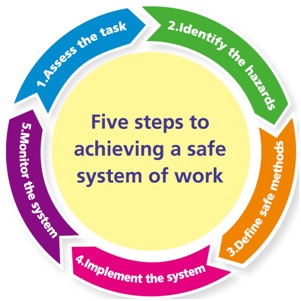Excavation Work
Excavation Work
1.1 What is excavation work?
Excavation work is defined as the removal of earth, rock or other material in connection with construction or demolition works using tools, machinery or explosives to form an open face, hole or cavity. Excavation work includes any earthwork, trenching, cofferdam, caisson, well, shaft, tunnel or underground working.
The person appointed to plan the lifting work should have adequate practical and theoretical knowledge and experience of the lifting work being undertaken.
Any construction work (including any work connected with an ‘excavation’) that is carried out in or near:
(a) a shaft, cofferdam, caisson or trench with an excavated depth of greater than 1.5 metres, or
(b) a tunnel
can be considered as a ‘high risk construction work’ for which preparation of a written Safe Work Method Statement (SWMS) is encouraged.
1.2 Who has safety and health duties in relation to excavation work?
Employer, contractor and occupier have the primary duty to ensure, so far as is reasonably practicable, that workers and other persons are not exposed to safety and health risks arising from the excavation work. The duty holder must manage risks related with all kinds of excavations at the place of work, no matter how deep.
The self-employed must ensure, so far as is reasonably practicable, that any person is not exposed to safety and health risks arising from his work.
Clients can make a substantial contribution for improving the safety and health management of excavation by apportioning sufficient funds for site investigation. They should be prepared to allocate further resources for site investigation during the course of construction if the anticipated soil or rock conditions, as exposed by the excavation, differ from the conditions predicted from the original site investigation.
Contractor has legal obligations under part XII of the Factories and Machinery (Building Operations and Works of Engineering Construction) (Safety) (BOWECS) Regulations to manage the risks associated with excavation work, including trenches. For example, the contractor must appoint a competent person to act as anexcavation supervisor (designated person) to carry out a duty under Regulation 113(2) of BOWEC Regulations. Contractor must consult, so far as is reasonably practicable, with the designer of the whole or any part of the structure (permanent or temporary) about eliminating and controlling risks.
Professional Engineer (PE) as a designer must ensure, so far as is reasonably practicable, that any supporting structure that he designed is without risk to safety and health, when used as intended. The PE must submit to the person who commissioned the design a written safety report that specifies the excavation work methods, hazards relating to the design of the supporting structure and control measures.
Project manager, project director or project engineer have a duty to exercise due diligence to ensure that the excavation work complies with the OSHA, FMA and regulations. This includes taking reasonable steps to ensure that the excavation work has and uses appropriate resources and processes to eliminate or minimise risks that arise from the excavation work.
Safety and Health Officer must ensure the due observance during the excavation work of the provisions of OSHA and Regulations, as well as the promotion of a safe conduct of excavation work.
Site Safety Supervisor (SSS) must ensure that the provisions of the FMA and Regulations are complied with and promote the safe conduct of excavation work within the worksite.
Workers have a duty to take reasonable care for their own safety and health and that they do not adversely affect the safety and health of other persons. Workers must comply with any reasonable instruction and cooperate with any reasonable policy or procedure relating to safety and health at the place of work.
1.3 What is required to manage risks associated with excavation work?
Every employer in a construction project that involved excavation works must ensure risks are managed by establishing a safe systems of work, as required under Section 15(2)(a) of OSHA, General duties of employers and self-employed persons. If more than one employers are involved in a construction project, each employer should cooperate in establishing safe system of work to protect their workers and other person that may be affected by risks that arise from excavation work.
1.3.1 Establishing safe systems of work
A safe system of work is a formal procedure which systematically examines work tasks to identify all potential hazards and then delineates safe working methods, such as SWMS, that ensure hazards are eliminated and risks minimised. A safe system of work is needed when hazards cannot be physically eliminated and certain elements of risk remain.
The five steps to achieving a safe system of work is illustrated in Figure 1. Those responsible for implementing a safe system of work should define safe methods by:
(a)considering work preparation and authorisation required at the start of any job;
(b)ensuring clear planning of job sequences;
(c)specifying safe work methods and necessary safety measures;
(d)including a safe means of access and escape, where relevant; and
(e)considering tasks such as dismantling and disposal of building materials at the end of each job.

Figure 1. The risk management process: Five steps to achieving a safe system of work.
Elimination of hazard should be the top priority. For example, trenchless technology can replace the need for excavation, apart from launch and reception pits and hence avoid many of the risks associated with open trenching. They also reduce risks to members of the public from open excavations and subsequent traffic disruption.
1.3.2 Safe Work Method Statements (SWMS)
If the excavation work is or involves high risk construction work, a contractor must prepare an SWMS before the high risk construction work starts. The SWMS must:
(a)identify the type of high risk construction work being done;
(b)specify the health and safety hazards and risks arising from that work;
(c)describe how the risks will be controlled;
(d)describe how the control measures will be implemented, monitored and reviewed; and
(e)be developed in consultation with workers and their representatives who are carrying out the high risk construction work.
In some circumstances one SWMS can be prepared to cover more than one high risk construction work activity being carried out at the workplace by contractors and/or subcontractors. For example, where there is:
(a)a risk of a person falling more than 3 metres; and
(b)a trench with an excavated depth greater than 1.5 metres.
In this case, the contractors or subcontractors can consult and cooperate to prepare one SWMS. Alternatively, they can prepare separate SWMS. If they choose to do this, they must consult with each other to ensure all SWMS are consistent and they are not creating unintended additional risks at the workplace.
1.3.3 Planning your work
One of the most important factors to be discussed at planning stage is the soil type that is to be excavated. Generally, all excavations, except the shallowest, require some support using trench sheeting.
Assessment by excavation supervisor is vital to study the likelihood of any changes in ground conditions and then review the working method accordingly. Further guidance on the general risk management process is available in the Guidelines for Hazard Identification, Risk Assessment and Risk Control (HIRARC).
Assessment by excavation supervisor must be preceded by a site investigation, undertaken (usually by the principal contractor) during the planning process and points to consider are:
(a)underground essential services – including gas, water, sewerage, telecommunications, electricity, chemicals and fuel or refrigerant in pipes or lines.
(b)previous use of site;
(c)location of existing buildings and new structures;
(d)results of soil investigations;
(e)ground contamination;
(f)water courses (including underground), level of water table and type of soil;
(g)location of storage and disposal of excavated material;
(h)the methods of transport, haul routes and disposal, amount of working space and storage required;
(i)the most suitable method of temporary support of the excavation walls;
(j)the number of people involved;
(k)local weather conditions;
(l)the length of time that the excavation will be open; and
(m)adequate emergency arrangements.
The position of all existing underground installations, such as sewers, mains (water or gas) and cables (electrical power or telecommunications) must be verified before the work begins. The pipe or cable should be isolated before work begins.
If excavation work is needed to repair mains (water or gas), piped services or cables (electrical power or telecommunications) which are feeding occupied neighbouring buildings, it is crucial that effective communication between the excavation contractors and the building occupants is established and maintained throughout all stages of the project. If the work obstructs the main or emergency doors from the buildings, then other egress arrangements should be provided.
Upon completion of the site investigation and work planning, meetings should be organised with the occupants of surrounding buildings and other properties so that any special arrangements can be communicated. Continual liaison with neighbours is an important element in the risk control strategy.
1.3.4 Consulting your workers
Consultation with workers and their safety and health representatives is required at every step of the risk management process. Usually, the construction work and projects decisions are made prior to engaging workers, therefore, it may not be possible to consult with workers in these early stages. However, it is essential to consult with them as the excavation work progresses.
1.3.5 Consulting, co-operating and co-ordinating activities with other duty holders
A construction site will often be shared by various persons, such as civil engineers and contractors. Persons with overlapping duties should exchange information about the risks associated with the excavation work including any traffic and plant movements near the excavation area. They should work together in a coordinated way so that all risks are eliminated or minimised so far as is reasonably practicable. Consultation should include discussions on the:
(a)nature and/or condition of the ground and/or working environment;
(b)weather conditions;
(c)nature of the work and other activities that may affect health and safety;
(d)static and dynamic loads near the excavation;
(e)interaction with other trades;
(f)site access;
(g)SWMS;
(h)management of surrounding vehicular traffic and ground vibration;
(i)type of equipment used for excavation work;
(j)public safety;
(k)existing services and their location;
(l)the length of time the excavation is to remain open;
(m)provision of adequate facilities; and
(n)procedures to deal with emergencies.
Related content
- pdf Excavation work hazards inspection guidance
- Guidelines on Occupational Safety and Health in Construction Industry (Excavation Work) 2017
- pdf e-Bulletin: Tapak Selamat Bil. 3/2015















